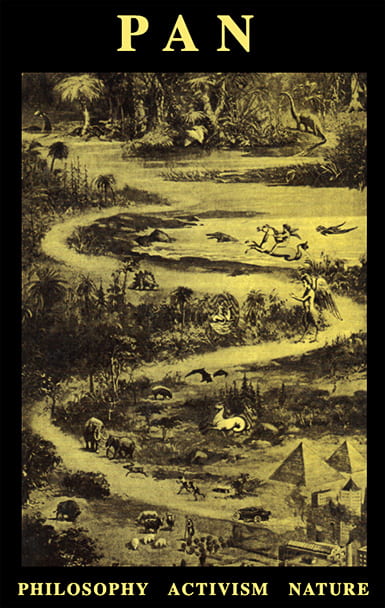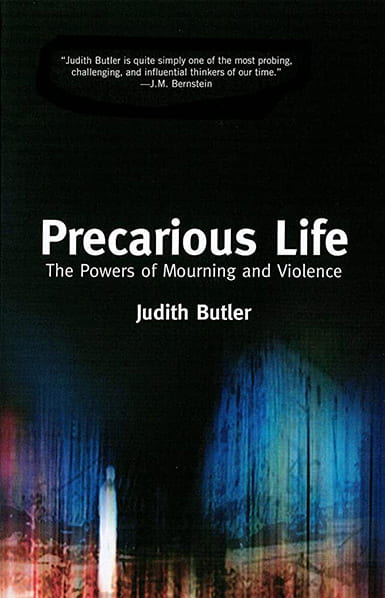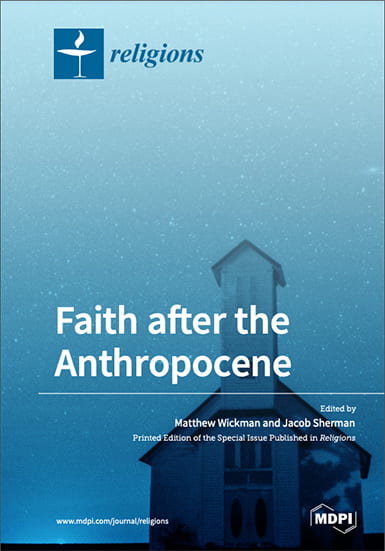
In Review
Climate Grief and the Secular Spirituality of Earth-Mourning
Illustration by Dadu Shin
By Dorothy Dean
In her recent collection of essays, Vesper Flights, English naturalist Helen MacDonald observes that awareness of the specific plants and animals in the natural world around you increasingly means “opening yourself to constant grief.” She is not alone in noticing the rising tide of grief that comes with awareness of climate change and its accompanying environmental devastation. The question of what to do with this climate grief is gaining momentum, because one of the increasingly salient features of our existence right now is the pain of watching the world burn. I am interested in the spiritual consequences of this grief and the possibility (and even necessity) of mourning as a spiritual practice in a largely secular context. MacDonald herself does not identify as religious, but she remarks that, when writing about environmental grief, she “kept trying to find the right words to describe certain experiences and failing.” Her “secular lexicon didn’t capture what they were like.”1 Spiritual discourse has the resources for touching this aspect of our present experience, and I argue that this discourse can and should be available, irrespective of whether one personally believes that spirituality and theology refer to metaphysical realities.
Drawing on the work of a small but growing number of scholars exploring the spiritual dimensions of climate change, I suggest that climate grief is a phenomenon with spiritual significance, and that mourning as a spiritual (but potentially secular) practice is a necessary step for honoring and dealing with “solastalgia.” Glenn Albrecht, an Australian of Sri Lankan and European descent, coined this neologism to capture the inchoate negative feelings that emerge as we observe the destruction of the world around us. A combination of solace, desolation, and nostalgia, solastalgia is “an intense desire for the place where one is a resident to be maintained in a state that continues to give comfort or solace,” as well as the “pain or distress” that results from watching that solace disappear and “the sense of desolation connected to the present state of one’s home and territory.” Albrecht’s neologism came in part from the consideration that, for many Indigenous people, the scientific terms “ecology” and “ecosystem” “fail to capture the emotional and cultural dimensions of the human relationship to land.” He wanted to avoid the neocolonization of reading bioscientific terms into Indigenous systems.2

PAN: Philosophy Activism Nature
I agree with Lisa Sideris and other scholars writing about human emotional responses to the continuing destruction of life on Earth: neither blind optimism nor paralytic despair is the appropriate reaction to the state of affairs that has led to solastalgia. Rather, it is time to mourn. Paradoxically, this mourning, which may at first glance seem to be a giving-up, is an essential step toward transformation.
While I do not pretend to offer definitive accounts of spirituality, secularity, or subjectivity (terms with multifaceted definitions that are still being debated), I do propose approaches to these concepts that I hope will make certain ways of being in the anthropocene legible to theological discourse. In this essay, I trace one of many possible lines through grief, grievability, and mourning into spirituality, in the context of a particular global-North secularity. With Judith Butler, I approach grief through the lens of what grieving does to the concept of the self. My contention is that spirituality (which I understand, broadly, as a subjectively meaningful connection with something that troubles the boundaries of subjecthood and affects one’s experience of oneself) is intimately connected to the disorientation of the self that occurs in the grieving process. Developing this kind of spirituality requires a potentially contentious use of theology—my suggestion for a secular spirituality of earth-mourning is based on Noëlle Vahanian’s secular theology and study of “madness”—and so this essay also obliquely revisits debates about the definition of theology and the gatekeepers of that definition. Ultimately, understanding earth-mourning as a secular yet spiritual movement reveals the potency of the unknown, making radical personal and societal transformation possible.
One grieves over something that is lost and will never come back again. You do not typically grieve for a lost sock, but you do grieve for a lost friend. Why? The sock is fungible (it can be replaced by another thing of equivalent value), and fungible things are not grievable. If you lost your sock and I handed you another one, you probably would not grieve. There is no relationship between you and the specific item—you just need a sock to cover your foot—so there is nothing to mourn. But if your best friend died, and I presented you with another person who more or less looks and acts the same, it is unlikely that you would be soothed. Your friend is not fungible.

Precarious Life
Certain billionaires have proposed terraforming other planets so that we (or, more accurately, they) might have somewhere else to move when this planet is used up. I am reminded of the scene in Christopher Nolan’s 2014 film Interstellar, where our heroes, the clear-seeing scientists and astronauts, leave behind the stubborn, blind farmer who senselessly wants to stay on an earth that has become nothing but fire and corn. The film conveys a certain sadness at that farmer’s intractability, but where is the grief for the earth that has been destroyed? There is no need to grieve if all you care about is resources for humans. Any given “resource” is potentially fungible. As something with value only insofar as it has utility for humans, the wasted Earth of Nolan’s film is only a cause for grief insofar as it represents humanity’s last hope for survival. Because a new, habitable planet is in sight, the ending of Interstellar is largely triumphant and hopeful; what pathos there is exists primarily in the lost relationships of the main characters. As long as you can focus on a future triumph for humanity (or, at least, a select set of humanity), you can forestall grief, and leap from mountaintop to mountaintop of human ingenuity and progress. Perhaps that is one reason for the appeal of these extraplanetary fantasies.
Mourning is the process by which one reckons with grief. Although I have allowed some slippage in my use of the two terms, grief refers more to the heavy burden of pain after a loss, while mourning is the process of lament and remembrance prompted by grief. Mourning for the earth is complex. It is not only complicated by our complicity in the ravages of the Anthropocene, but it is also a mourning that is in process, a proleptic mourning for something that yet lives. Albrecht intends for his concept of solastalgia to “[capture] the chronic distress and melancholia of the lived experience of negative environmental change. It is as if one is living with a loved person who is seriously ill and who is suffering.”3 Earth-mourning is akin to watching someone beloved slowly die, while continuing to hold out hope that a cure may be found at the last minute, and knowing that even that cure can never fully restore the earlier vitality of that person.

Vesper Flight
Sideris and other scholars working on climate grief frequently reference Judith Butler’s Precarious Life when discussing mourning and violence. Butler suggests that mourning is “when one accepts that by the loss one undergoes one will be changed, possibly for ever. Perhaps mourning has to do with agreeing to undergo a transformation (perhaps one should say submitting to a transformation) the full result of which one cannot know in advance.” The point is the inability to plan or predict. Even if you say, “I am going to mourn now,” it is impossible to know exactly what that will lead to. This experience of mourning, Butler continues, “deconstitutes choice at some level.”4 Mourning means agreeing to put oneself outside of one’s control. Little wonder that titans of industry would want to avoid it.
Thus, the work of mourning is intimately related to questions of subjectivity: who you are, personally and specifically, and who you become when you lose something that was part of your self-constitution. I am what I am by the ties that constitute me. Butler writes that when we undergo mourning, “something about who we are is revealed, something that delineates the ties we have to others” and demonstrates the extent to which we are composed of our relationships with others. Consequently, when we lose these ties, we are unable to recognize ourselves anymore. Hence the need to come together in ecological mourning, to find that new self in community. Butler is writing about mourning for other humans in their book and uses the words “I” and “You.” But if we consider the earth to be a “You” (in Martin Buber’s “I-and-Thou” sense), then Butler’s work still applies.5 Who am I when my You is gone? Who am I if the earth that was my solace is irrevocably changed?
In addition to whatever else they may be, these are spiritual questions.
For a while now, statistics have shown that an ever greater share of the population identifies as having “no religion.” In the United States, many young people (those who, incidentally, will suffer the most from climate change) remain unconvinced by any existing religious organization or tradition. What will help them process this mourning and grief? I propose that secular spirituality can be one option for those beyond the boundaries of religious conventions.

Special issue of Religions
In developing a secular spirituality, I draw on secular theology, a descendant of the mid-twentieth-century radical theology movement. “Theology” and “spirituality” are not synonymous. However, I would argue that secular theology—particularly as understood by Noëlle Vahanian—has the potential to meet a spiritual need, because secular theology is a discourse based on desire, which is the other side of grief. Vahanian notes that what she calls “theological desire” exists even outside of accepted religious bounds. It is, perhaps, a kind of spiritual impulse beyond doctrine or creed. Meanwhile, Butler has argued that desire is the driving force behind grief. Can a secular, theological desire engage the inherent spirituality of secular grief? Grief and desire are intimately connected because neither allows the subject to remain entirely whole and in control. Butler says that it seems “so clearly the case with grief” that “we’re undone by each other.” But, they note, the only reason it can be that way is because that mutual becoming-undone “was already the case with desire.” In both desire and grief, Butler writes, “one does not always stay intact,” even if one wants to.6
The state of not remaining emotionally or mentally intact is similar to what was once called “madness.” Vahanian develops this concept in her discourse on theological desire. She describes madness as an almost primordial ground of being; it is an excess of awareness of reality—being too aware of every sensation—and “reason” is what allows one to silence those sensations and confine oneself to a particular logic. Reason, as defined by Vahanian, is “a suspension of thought which produces sanity.” This kind of madness, she asserts, is at the core of being alive. Moreover, she writes, “whenever I decide what is . . . rational, what is sensible, I decide what is human against what is animal . . . I exorcize the madness that founds me and the groundlessness that confounds me.”7 That is, the human process of rationalizing and constructing the self is a movement away from animality, and, I would add, away from the earth as a whole.
Grief and spirituality meet at the juncture of madness, which I use here to indicate the uncertainty and self-dissolution that comes from giving oneself over to the unknown. Arguably, spiritual practice can function as a “rebellious no!” (to use Vahanian’s phrase) to the order of logic that separates us from our own animal roots and our dependence upon the earth; it is a “no!” to the order of things—an embrace of the same madness that had to be silenced in order to create logical, reasonable subjectivity and to justify exploitation of nonhumans and those peoples who could be defined out of their personhood. To embrace grief in all its self-deconstituting power, is, in a sense, to embrace the madness that defies clear human/animal/earth distinctions. Grief troubles the self, threatens to release the grip of the rational and to reveal that underlying madness. Similarly, Butler describes “the disorientation of grief—‘Who have I become?’ or, indeed, ‘What is left of me?’ ‘What is it in the Other that I have lost?’ ” This disorientation and these questions put the self, the “I,” “in the mode of unknowingness.”8 A secular spirituality of earth-mourning engages this dissolution of subjectivity.

The Rebellious No
There is no happy ending to this story yet. There is certainly no cause for optimism. One common theme I have noticed in scholars concerned with climate grief is the insistence that we need to abandon optimism. Finnish environmental theologian Panu Pih-kala, for example, observes that optimism simply isn’t up to the challenge of this era. Instead, what is needed is hope, and that is not the same thing.9 But how do we distinguish between optimism and hope? Hope—real hope, not false optimism—is only possible after going through and living in grief. Sideris, drawing on the work of author Rebecca Solnit, argues that uncertainty (like the uncertainty of the self in the face of grief, as well as uncertainty about what the future holds) is what allows room for hope. Sideris develops the uncertainty idea using Solnit’s metaphor of the dark, because the unknown is a darkness of both endings and beginnings, both the tomb and the womb. Within this darkness, we are exhorted to remember that we have been “surprised by events in the past.” This appeal to the potentiality of darkness appears in MacDonald as well. MacDonald urges us to take action even if we cannot see the way forward. Sometimes we are unable to see that “miracles . . . are there . . . waiting for us to find them.”10 To mourn is to open one’s eyes to that fecund darkness.
Avoidance of mourning means a failure to confront the dark, which thus forestalls the possibility of meaningful change. True earth-mourning cannot be anthropocentric. Sideris argues that climate activism that decries climate change because of the loss of resources useful for humans, which she calls humanist climate activism, does not allow for mourning the nonhuman and thus cannot produce “authentic change.” The work of grief is to “effect change in the mourner” in proportion to that which was lost, Sideris writes. But in order for that to happen, “there must be a genuine reckoning with the irreplaceable nature of what is lost.”11 That is, there must be mourning for the nonfungible nonhuman lives and ecosystems that we have destroyed. Trying to skip over this mourning with blind optimism about the future perpetuates the attitudes that got us into the mess in the first place. By contrast, embracing the disorientation of grief through a spirituality of earth-mourning, we may find ourselves paradoxically oriented by a potentiating darkness.
The moral of the story is that personal and societal transformation can happen through mourning. The concrete fruits of a secular spirituality of earth-mourning would look much like other mourning traditions: coming together to talk, sing, and cry; speaking poetically of ultimate concerns; stepping outside of denial. Most importantly, it involves mourning with the ecological and as the ecological. At the heart of a secular spirituality of earth-mourning is acknowledgement of participation in something that transcends the personal self. This self-transcendent “something” is literal and concrete: it is the totality of all the interconnected life forms and ecosystems of planet Earth. In earth-mourning, the life within us mourns the life outside of us, acknowledging and strengthening the connection between all of us, human and nonhuman, and honoring the collectivity of our grief.
Notes:
- Helen MacDonald, Vesper Flights (Jonathan Cape, 2020), 225, 286 (emphasis added).
- Glenn Albrecht, “ ‘Solastalgia’: A New Concept in Health and Identity,” PAN: Philosophy Activism Nature 3 (2005): 41–55, at 45; Albrecht, “Negating Solastalgia: An Emotional Revolution from the Anthropocene to the Symbiocene,” American Imago 77, no. 1 (2020): 9–30, at 13 and 11.
- Glenn Albrecht, “Solastalgia and the New Mourning,” in Mourning Nature: Hope at the Heart of Ecological Loss and Grief, ed. Ashlee Cunsolo and Karen Landman (McGill-Queen’s Press, 2017), 299.
- Judith, Butler, Precarious Life: The Powers of Mourning and Violence (Verso, 2004), 21.
- Ibid., 22. Martin Buber, I and Thou, trans. Ronald Gregor Smith (Bloomsbury, 2013).
- Noëlle Vahanian, The Rebellious No: Variations on a Secular Theology of Language (Fordham University Press, 2014), 51. Butler, Precarious Life, 22.
- Vahanian, The Rebellious No, 70–71, 75.
- Butler, Precarious Life, 30.
- Panu Pihkala, “Death, the Environment, and Theology,” Dialog 57, no. 4 (2018): 287–94.
- Lisa H. Sideris, “Grave Reminders: Grief and Vulnerability in the Anthropocene,” Religions 11, no. 6 (2020): 14, doi.org/10.3390/rel11060293. MacDonald, Vesper Flights, 75 (italics in original).
- Sideris, “Grave Reminders,” 7, 3.
Dorothy Dean, Assistant Professor of Religion at Hastings College, has published on ecofeminism and the intersections of philosophy, religion, and ecology. Her most recent article, “Are Ashes All That Is Left? Grace Jantzen’s Aesthetics and the Beauty of Biodiversity,” appeared in 2022 in “Biodiversity and the Religious Imagination,” a special issue of Religions.
Please follow our Commentary Guidelines when engaging in discussion on this site.

